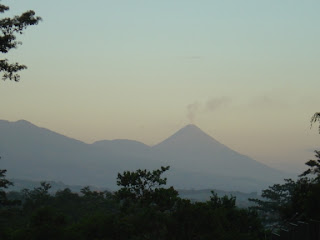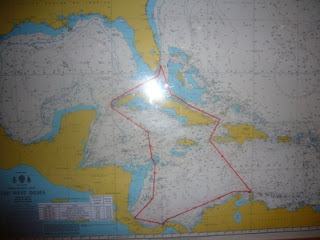
Aruba is not a well known diving destination and is considered at best a C-. This is because it is a sandy bottom island without much in the way of coral reefs to attract the kind of interesting critters that divers usually enjoy viewing.
As is common on a boat dive this was what was called a 2 tank dive. I was not sure what to expect given the age group on board in the way of dive companions. To the dive shops credit, they wanted to see your dive log book, be sure that you had been diving in the last 2 years, and were of good health.
As the group gathered, I was at first very surprised to see how many people were gathering at the pier for the off-shore water dive because some of them did not look fit enough for what was coming up. After we filled out all the paperwork I noticed some had a white form and some a pink form. Only the divers had the white form, which meant that only 25% of the folks were divers totaling about 12.
It was an eclectic group with varying dive experience. I have been diving a long time, but have done so sporadically usually when visiting the tropics. Since Minnesota is not a dive destination, it does limit your opportunities unless you like going up north to the mines.
The first guy I met was a retired Air Force Colonel named Dave (thank God I did not bump into him at a dinner with one of my military stories). He lived in Florida on the panhandle and was full of stories at my behest about the Air Force and what he had done. I figured I could use them at a later date when I assumed my Air Force Colonel role. He flew F-101 Voodoos fighters and an assortment of other gun-ships that mostly cleared out known trails in Vietnam that enemy troop traveled on. In his squadron he lost 6 of 12 aircraft to enemy fire all of which had 16 man crews. Most crews that were shot down were lost staying with their aircraft. Those few that did bail out were actually picked up in a similar manner to the movie Bat 21. Dave told me one airman that was picked up and had to spend a night in the jungle had his hair turn completed white with a week of his rescue.
I digress. As we went around sharing our dive experiences here was the make up of the group.
- Air Force Dave had 450 dives.
- Tattoo dude (about 27 years old) was doing his first open water. He was quiet and kept to himself most of the time.
- Bud and Cathy from Delaware had about 75. They had most of their own gear and knew what they were doing.
- Older Iwo Jima Japanese man had 1,600. He didn’t really talk to anyone but was a very good diver.
- Royal Navy (Irishman) Oil rig diver had 2,600. This guy was an exceptional diver who had done cold water diving to inspect and certify welding on oil rigs. He also had done a lot of wreck diving in Scapa Flow Scotland which is very cold and requires and dry suit.
- Linda the photographer: 10 dives and most light recreational.
- The quiet couple: around 100. Very competent.
- South Carolina man (about 25 years old): 5 dives, had fun and burned a lot of air.
- One legged Bob that looked like the guitar player from ZZ Top had about 50. Very capable and knew his limitations.
- And me with about 30 with my last dive being in Sierpe, Costa Rica with buddy Jim Cameron at Cano Island in September 2005.

The first dive was a deeper dive to 60 feet to view an old German freighter that was deliberately sunk during WW2. Here is the History. Aruba, being a Dutch colony, was on very friendly terms with the varying European merchants sitting in the harbor. When Germany invaded Holland, the Dutch government ordered the local PM’s of all Dutch colonies to seize everything German from money to property. The local military commander motored to the German ship anchored in the harbor and informed “Hans” the Captain what happening and that he needed to surrender his boat. He understood and requested that he be allowed to address his men, inform them of what was happening, and ferry them ashore as requested by the Dutch. He sent most of his men ashore as instructed, but stayed aboard with his ranking 2 officers and scuttled the ship by blowing it up. Bloodied and alive, he presented himself to the Dutch commander who immediately put him in the brig. The only problem was that they did not have much of a brig. It was more like a room, so they shipped him to Bonaire where he had a Papillion experience of hanging out in huts on the beach with nowhere to go until the end of the war. Being a man of vision, after the war he purchased the huts where he stayed and created the first “resort” of its kind in the Caribbean. He spent the next decade building them up and is now a local Hospitality legend.
Back to the dive. With all that said we began to buddy up and check our equipment. This was a little different than some dives I have been on because they don’t baby-sit you and assumed you knew what you were doing with the equipment. Fortunately most everyone knew what they were doing and jumped in at about 10:30 and made their way to the freighter.
I was paired with Colonel Dave and 1-legged Bob who got along deceptively well. Air temp was around 90 and water temp was bout 80, so it was perfect dive conditions. Soon after we were feet wet, we did a very poor job of staying with our buddies and violated every safety rule there was at this depth. I was at 60 feet with Dave beside me and Bob trailing about 10 feet up. Soon we lost Dave, as he veered in another direction leaving me with Bob. I kept rolling to spot him and be sure he was there and all was fine for about 10 minutes, then he disappeared and it was just me. Usually in this situation you stop what you are doing, locate your buddy, and then proceed. A spend about 7 minutes looking around for my boys, noticed Bob had headed for the surface and decided to make my way back to dive boat via the freighter.
10 minutes later if found the wreck and it was much bigger than I expected. I had a sense it was near when the area went from no fish activity except for the occasional red snapper to huge schools of them gathering together. Looming large like the Titanic movie, it appeared very suddenly through the haze. It was very eerie and foreboding at first, because it was so big and there was nobody around. I started at the stern and made my way to the bow. It was broken in half, so the super structure was visible first. The cargo hold areas were broken open and the mastheads jetted out towards the ocean surface. Fish were everywhere and were as much fun to play with as exploring the freighter. Since the ship was in relatively shallow water, under 75 feet, it was easy to swim the sides as well as poke around through the top.
Since I spent too much time earlier in the dive trying to locate my buddy team, I was trying to be mindful of my air supply and was not able to be at the wreck as long as I would have liked, so when I hit 700 pounds I made my way back to the safety line hung out for a compression stop at 15 feet for 10 minutes.
I should probably mention for comparative context that you start with 3,000 pounds of mix in the tank and it lasts anywhere from 30 minutes to an hour depending on how deep you dive and how skilled you are at breathing.
I was last on the boat and found most had gotten to see the freighter but a few did not. In retrospect the dive master should have gotten everyone there and then let them explore on their own as they wanted. It would have given everyone more bottom time and made for a better experience.
Back on the boat we took the recommended 1 hour break between dives to let the Nitrogen work its way through our system then readied ourselves for the next dive called the “Archway” dive. More on the name later.
Aruba is a sandy bottom profile that makes it very tough to navigate because everything looks the same making it very easy to get lost and get turned around. The next dive did not have a dominant landmark so we all stuck together in 2 large groups and played a loose game of follow the leader with the dive master. One-legged Bob and the first time tattoo guy sat out the second dive. Tattoo guy looked completely freaked out about being in the open water at depth and Bob was just tired. I was impressed that Bob did this in the first place and with a level of skill and confidence.
We visited 4 wrecks of a smaller magnitude that had a lot of fish activity. This was a much shallower dive at 25-30, so the light was better for photography and seeing the aquamarine colors. There was more sea life on the ocean floor than Dive 1, so there was more of a mix of wreck viewing and critter viewing. There was mostly fish of color and crabs running along the bottom, but none of the big boys that can make it excited such as Morays, sharks, barracudas, and sting rays. Those guys were in abundance in Costa Rica but now so here.
The arch was from a ship and was much smaller than I expected. Made of metal it had a lot of sea growth on it which made it popular with the local fish community.
Skilled diving is about your management of breathing and buoyancy. As you get more accomplished, you breathe less air thus allowing you more time to be in the water. Effective control of your breathing also helps to manage your depth rather than use your BCD (buoyancy control device). If you are able to maintain a consistent altitude, it makes for a better dive and more bottom time. There is always a comparison at the end of each dive between divers to see how much air you have left in your tank. The more air the better. You never want to be the guy with only a little amount of air left.
The next dive will be in Grand Cayman. Most of the group will be going again and Cayman is a very different dive experience than Aruba.
All in all a great success and met some nice people along the way.









































